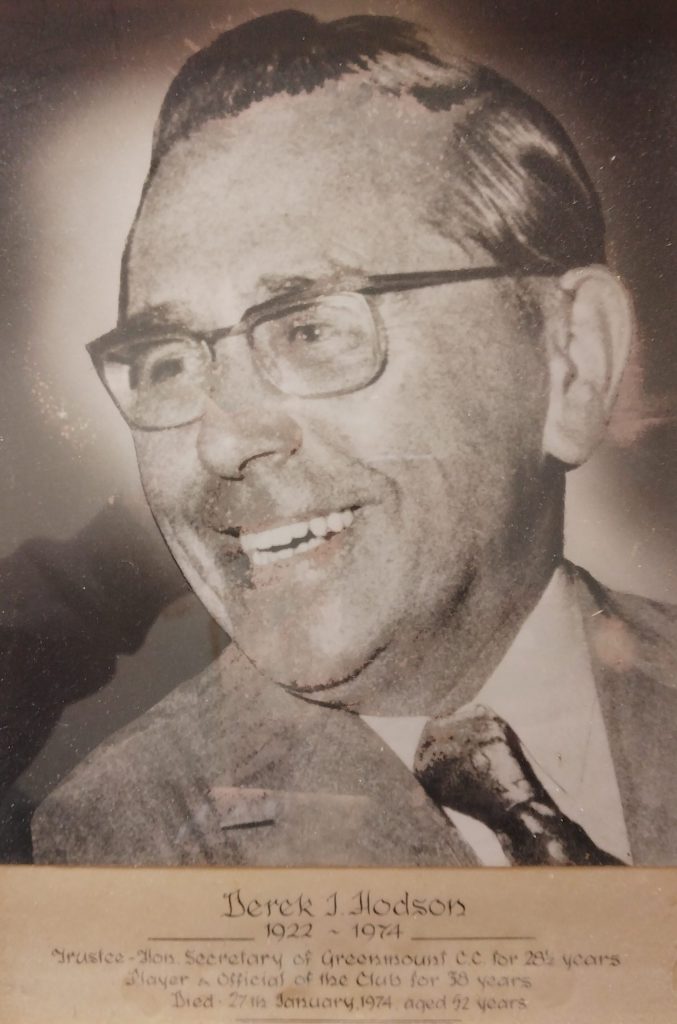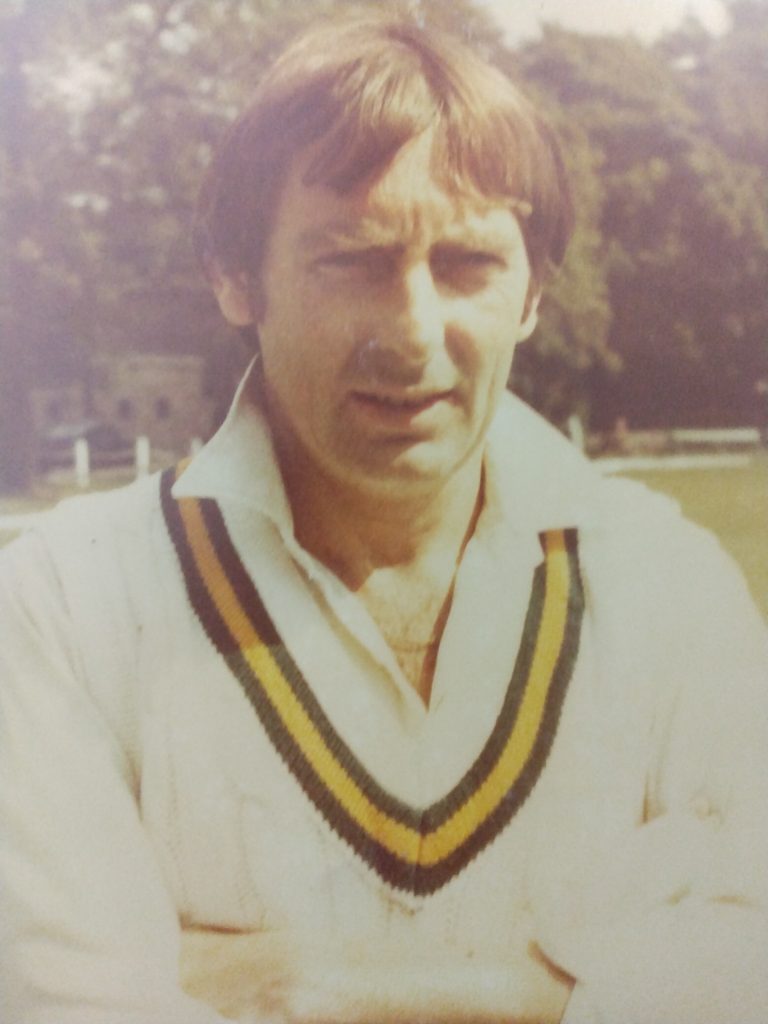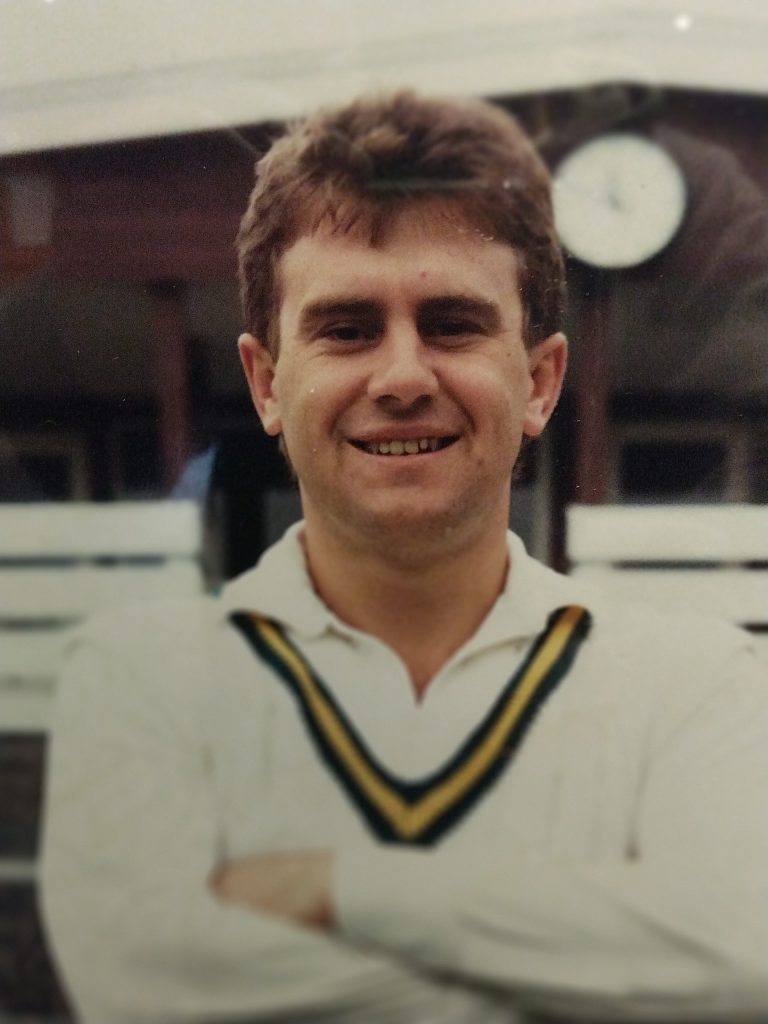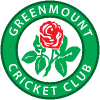History of the club
By Phil Thorp & Ron Hodson
THE earliest mention of a cricket team in Greenmount was in a Bury Times article which described a match having taken place between ‘Green Mount and Tottington’ in 1867.
According to Dick Scholes, a stalwart clubman in the 1920s and 1930s, the club initially played on a field in Holcombe Road, in the vicinity of what is now Shepherds Close and moved to the current Brandlesholme Road ground in 1872.

The village was known as ‘Green Mount’, spelled with two words, well into the 20th century and in the early days was little more than a hamlet with approximately 400 residents. Nevertheless the village boasted a village policeman, a barber’s shop, a clogger and boot repairer, a chip shop, a baker, a football club, two pubs with bowling greens, a railway station as well as the cricket and golf club.
In 1921 the club erected a ‘new’ pavilion. Prior to that, perhaps from its inception, players had to use in two very small changing huts about 10 foot by 8 foot and painted in blue and white stripes. In those days the scorer had to sit outside the dressing rooms, only the square was mown, with posts and wire to keep local farmers’ cows off the wicket! The outfield consisted of long grass with a path mown between the huts and wicket for the batsmen.
Players fielding at the ‘Woodcock’s End’ (the part of the field now known as ‘Cowshot Corner’) even had a pond to contend with and the huts were much nearer the centre of the field than the present boundary as the field was enlarged in the 1950s.
A photograph of the 1921 pavilion can still be seen in the club, when it was officially opened. The then president, Oliver Ashworth, acquired an old army hut which volunteers dismantled and erected and a local joiner, George Parker, oversaw operations. The hut was raised on brick pillars with sleepers for steps and a wicket fence was erected around a seating area outside. An engraved walking stick, presented to Mr Parker for his efforts, can still be seen in the club.

For the official opening, Lancashire and England’s Ernest Tyldesley, who had just scored six consecutive centuries was engaged on the day and a large crowd ringed the ground to watch this famous batsman.
The club’s slow left-arm bowler, ‘Darby’ Beswick, sent down the first over and off the third ball Tyldesley edged a catch. There were cries of ‘drop it’ from the spectators but it was safely held and the international ‘walked’ much to the disappointment of the assembled crowd.

It is thought that from its earliest days the club played in the Bury and District Sunday Schools League and after the championship was won in 1932 it was decided to join the Bury Amateur League which was regarded as stronger and contained local clubs such as Brooksbottoms, Walshaw and Edenfield.
This year was also notable for another reason. Previously the club was known as Green Mount Congregational Cricket Club due to its connections with the village church but, at an extraordinary meeting in the village school, it was decided to drop the ‘Congregational’ and the Sunday school connection was dropped.
This split from the church had been coming as in 1930 an application to join the Bolton Association was turned down due to the league raising objections to the outfield not being mown. To try and get round this impediment some players mowed the outfield with a hand mower on Sundays which caused complaints from the church pulpit.
It was easy to understand the church’s misgivings as the club was still part of the church and Sunday school at that time. Indeed, it was a rule that only players who attended Sunday school could be selected to play. Nevertheless, the desire to play higher league cricket as a village club was put to a crowded meeting and was passed by a large majority. In effect the club seceded from the church but there was no bad feeling in doing so.

Somehow the club carried on through the Second World War but sadly, no less than seven of the players lost their lives in the conflict: Ian Adamson, Harry Barrow, Gordon Butterworth, Neville Pilling, Billy Platt, Kenneth Savin and Joseph Scholes. A memorial stone to their memory can still be seen on the roadside.
In the 1940s one of the village’s number of Channel Island evacuees who was a landscape gardener and forester was engaged to trim the trees on the roadside, but went further and chopped a number down! Many protests were made in the village but the end result was better spaced, healthy trees that are still a splendid feature of the ground today.
Following the tree incident the evacuee more or less levelled the ground and filled in the pond. Infilling of approximately three feet was necessary along the roadside and it turned out to be a costly job with club members having to resort to a bank loan to pay the bill that took a number of years to pay off.

In 1947, the club were founder members of a new association, the North Western League which was believed to be a much higher standard than the Bury Amateur League. It was a prerequisite that each club should employ a professional and Green Mount appointed groundsman Reg Denton, despite being at the tail end of his career. However, the rule was soon relaxed and the club reverted to being all-amateur.
This second year after the end of the war proved to be an eventful one for the club. Not only was a large tackle shed and scorebox built but after being informed that Thwaites Brewery had taken over the club’s landlords Bury Brewing Company, president Clifford Mills contacted them and took a major step by buying the ground along with the adjacent field that is now the village green for the sum of £300.

There was some opposition to this decision within the club and once again a bank loan was acquired. However, a Manchester textile businessman, with no connections to the club, offered £150 towards the cost on the proviso the club raised the balance. Jumble sales and other fundraisers were held until it was decided to sell the adjacent field to Tottington Urban District Council for £100 with the request that the council lay it out as a children’s recreation ground.
1967 was not only the club’s centenary year but was the year the present log cabin pavilion was erected. The old 1921 pavilion was very decrepit with no sanitation and gas and water had only been laid on in later years. For many years the committee discussed a new pavilion with bar but rising post-war costs prevented action and it remained a dream. Plans for a modular, box-type structure costing £10,000 had been looked into but it would have cost a similar amount to equip the building, yet it was felt that without a bar and social section it would have been difficult to maintain the club.
On learning that Egerton CC had put up a Norwegian cut-log building, committee members travelled to inspect it and it was decided to go down the same road. After contacting a number of local breweries to no avail, Vaux Brewery of Sunderland, offered a loan for the construction and by the end of November 1967 it was in use. The official opening of the club was in early 1968 when Brian Statham, the Lancashire and England fast bowler, was guest of honour among more than 200 guests including local dignitaries.

Meanwhile, on the field, in 1970, the North Western League found itself short of numbers when some of its clubs joined other leagues. Greenmount and Woodbank proposed the forming of a new league, the South East Lancashire League, but a failure to attract clubs killed the idea off and both clubs joined the Lancashire and Cheshire League with other North Western League clubs.
In 1973 the club engaged big-hitting extrovert Mike Bocarro as professional and he was followed by John Booth, a dedicated cricket professional of some standing but arguably the most influential paid man the club employed was Terry Stewart, a fast-medium bowler who could seam and swing the ball and hard-hitting middle order batsman, who took the club from Lancashire and Cheshire League second division outfit to first division powerhouses in a short space of time.
1980 proved to be a landmark season for the club for not only did the first team win the division one championship but the second eleven won their respective divisional title while the third team finished top of their section in the North Manchester League. This impressive achievement was marked by a framed commemorative memorial featuring all threes league table and individual photographs of players, officials and scorers which can still be seen in the clubhouse.
In the early eighties the club’s ambitions took a new turn when they applied, and were accepted, into the highly-competitive Bolton League, and in 1984, their first season, they reached the final of the league’s knockout competition the Hamer Cup only to be defeated by Kearsley in a dramatic last ball defeat at Horwich CC.

In keeping with the standard required to compete in their new league, a decision was made to start hiring overseas professionals of a high calibre, beginning in 1986 with Australian Brendan McArdle. Barbados-born fast bowler Franklyn Stephenson followed in 1987 when the club narrowly missed out on the league championship to Farnworth Social Circle.
However, there was no denying the club twelve months later when they claimed the league title in fine fashion. Paid man in 1988 was soon-to-be Australian cricketing legend Mark Taylor who had a fabulous season, scoring in excess of 1400 runs as the Bolton League championship was secured. Also worthy of mention that season was Australian overseas amateur Patrick Farhart who made a massive impact with his impressive swing bowling.
Further notable Australian professionals followed including Jamie Siddons (South Australia) in 1989, Wayne Phillips (Australia and South Australia) in 1990 and Aussie legend Matthew Hayden who broke Mark Taylor’s batting record with 1438 runs in 1992.
The nineties also saw first team debuts for two English international stars, albeit of football not cricket. As teenagers, both Gary and Philip Neville – sons of club stalwart Neville Neville – showed their undoubted cricketing talents at Greenmount before going on to find fame and fortune with Manchester United and England.
The club, captained by Gary Chadwick, finally won the coveted Hamer Cup in 2000 in what was their fourth final. Fittingly, it was at the same Horwich venue that had been the backdrop for their heart-breaking 1984 defeat 16 years earlier. On this occasion, Tonge were put to the sword thanks in no small part to professional Saeed Anwar junior’s unbeaten 79 and six wickets.
Two further Hamer Cup successes followed in 2003 and 2007 before the club recorded an amazing treble in 2011. Not only did the first team win the Bolton League, they added the Hamer Cup, defeating Kearsley in the final, then capped an impressive trio of successes by overcoming Walkden in the final of the Lancashire Knockout at Old Trafford. Man-of-the-match Andy Kerr hit a crucial unbeaten 100 to add to his record of smashing the Bolton League amateur batting record for most runs in a season (1,477).
The season’s haul was a just reward for skipper Mark Stewart – son of former professional Terry – who had featured in most of the 23 previous league campaigns since that 1988 triumph. A fast-bowler with an unquenchable will to win, Stewart had been a regular in the Bolton League inter-league squads and even his fiercest rivals would not deny him his first championship winners’ medal.

Throughout the 20th century and into the 21st, a number of club officials have been extremely influential in taking the club forward. The Hodson brothers, Ronnie and Derek, had the foresight to push for the Log Cabin development in the mid-1960s while, no less important, club stalwarts Tony and Gordon Horrocks – along with Cyril Butterworth – each gave or have given more than sixty years’ service both on and off the pitch in various capacities. Without their enthusiam and hard work the club wouldn’t be the force it is today.

In 2016, after a 32 year stretch in the Bolton League and following a meeting of players, officials and members, Greenmount decided to join the newly-formed Greater Manchester Cricket League. Then club chairman Bill Elkin was instrumental in helping set up the new league which featured clubs from the Bolton League, Bolton Association, Lancashire County League, Central Lancashire League, Saddleworth League and the North Manchester League and has promotion and relegation as part of its format.
That arrangement served to remind the club just what a competitive league the GMCL is when, after being placed in the Premier League for the inaugural season, they finished their first campaign in one of the four relegation places. However, they rounded off their 150th anniversary year with a speedy promotion back into the top flight at the first attempt.
When an opportunity to join the iconic Lancashire League arose in 2020, club officials, led by then chairman Rob Kilvington, wasted no time in applying and were delighted and honoured to be accepted.
